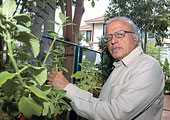 |
| Let farmers have an SAZ: Swaminathan's
new concept |
When the father of the
green revolution talks of setting up Special Agricultural Zones
(SAZs) along the lines of Special Economic Zones (SEZs), it merits
serious attention. M.S. Swaminathan is convinced that SAZs are
the way forward for Indian agriculture. "Urban India thinks
of agriculture as some kind of food factory for it. It is not;
it is the backbone of 70 crore livelihoods and it will be disastrous
for India to jeopardise the income and work security that agriculture
provides," he says.
SAZs, says Swaminathan, will conserve prime farm land for agriculture,
optimise the economic and social benefits from good farming practices,
rationalise the use of water, realise the untapped production
potential of Indian farms and ensure national food sovereignty.
APEDA Director Sanjay Dave emphasises the "good farming
practices" that could accrue from an SAZ that incorporates
a model farm within. Apart from healthy cultivation mechanisms,
certification is increasingly becoming an important part of agriculture.
"We need an Indian GAAP (generally accepted agriculture principles)
for agriculture a la Thailand. This is very necessary not just
for the export market but for our own requirements too,"
he says. Food safety is a major concern among consumers and large
companies like Reliance, Bharti and others, which are entering
the retail trade in a big way (see Agriculture's Second Wind,
Page 112), will want to know what they are buying. "Wal-Mart,
which is a massive buyer of agricultural commodities in the US
and some other countries, monitors every aspect of safety, quality
and traceability (which farm it is grown and when)," he adds.
This requires technology and documentation and SAZs will facilitate
this "as infrastructural and operational costs will be shared
by large groups of farmers," he points out. APEDA has successfully
implemented this for grape exporters in Maharashtra, Andhra Pradesh
and north Karnataka.
Then, there's the marketing aspect that is almost totally neglected
in Indian agriculture at present. Manju Jha, General Manager (Operations),
M.R. Morarka-GDC Rural Research Foundation, a leading resource
organisation offering solutions for sustainable agriculture, points
out that a concerted marketing effort is needed to weed out middlemen
who make a killing at the expense of farmers. "An SAZ should
have warehousing and post-harvest and processing facilities to
preserve and add value to crops. They should also organise and
participate in trade fairs to promote their products," she
adds.
But given the controversy over SEZs, will Swaminathan's idea
see the light of day? That's the million dollar question, but
given the credentials of the man behind the concept, the government
can ignore it only at the risk of India's food security.
GM Crops:
Boon or Bane?
The Supreme Court will have to take the final
call on whether or not to allow genetically engineered crops into
the Indian market.
By E. Kumar Sharma
 |
| Seeds of discontent: Bt
Cotton farmers in Andhra |
|
|
The debate over genetically modified
(GM) crops is currently being heard by the Supreme Court (SC)
which had imposed an interim ban on their field trials and subsequent
commercialisation in September last year in response to a public
interest litigation (PIL) filed by Aruna Rodrigues. The key concern:
the release of potentially dangerous living organisms into the
environment (unlike in the case of pharmaceuticals where experiments
are carried out in a closed environment).
The All India Crop Biotechnology Association, an association
of companies engaged in agricultural biotechnology (mostly seed
companies), defends GM crops, saying the availability of arable
land in India will decline from 170 million hectares now to about
100 million hectares by 2020. The number of farmers available
for agriculture will fall by more than 50 per cent. "So there
is an urgent need to increase agricultural productivity through
research and newer production technologies," says R.K. Sinha,
Executive Director, All India Crop Biotechnology Association.
At the moment, only Bt Cotton is available commercially in India
(only those varieties approved prior to the sc order), though
there are problems relating to pricing-some seeds cost as much
as three times the regular ones. Besides, about 21 food crops,
mostly vegetables and rice, which were being tested and undergoing
trials, have now been put on hold following the sc order.
Greenpeace, which is running a campaign against GM crops, warns
against "the irreversible, uncontrolled, and potentially
dangerous release of genetically modified organisms (GMOs) into
the environment" and likens them to a new drug with potentially
dangerous side effects that cannot be contained "as, at the
end of the growing season, the crop is generally ploughed into
the soil". There's no effort to get rid of every single trace
of a GMO. In 2005, it points out that genetically engineered (GE)
rice was sold in Chinese markets while it was still under field
trials. Divya Raghunandan, GE Campaign Manager at Greenpeace,
says: "The halo around GE crops is gradually fading and consumers
across the world are increasingly rejecting it."
But the GM lobby is quick to defend its project. "We have
regulations in place (to monitor safety) and the case of Bt cotton
has shown that there is readiness on the part of farmers to adopt
this technology," says K.V. Subbarao, Country Manager, phi
Seeds, a Dupont company. Adds K.C. Ravi, Director (Public Affairs),
Monsanto India, another leading company in the GM space: "The
Indian regulatory system is among the best and has some of the
most stringent guidelines in the world for commercialisation of
GM crops."
But Greenpeace's Raghunandan is not convinced. "There has
been no public debate on whether GE is a good solution for the
agriculture crisis. And though we have regulations, they are not
followed," she says. "We have no GM labelling law to
indicate the threshold level or percentage of contamination that
will allow the consumer to make an informed choice," she
points out.
The country also does not have a mechanism to segregate and
test levels of GE contamination.
There is, obviously, no meeting ground between these competing
arguments. The Supreme Court, which will hear the matter next
on May 1, 2007, will have to take the final call.
|







